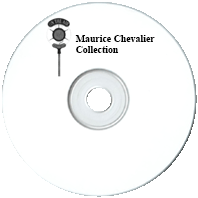

Began working with his brother as a circus acrobat to support his family, French revues and his way with the ladies gave him is start in entertainment.

16 old time radio show recordings
(total playtime 6 hours, 53 min)
available in the following formats:
1 MP3 CD
or
8 Audio CDs
Text on OTRCAT.com ©2001-2025 OTRCAT INC All Rights Reserved. Reproduction is prohibited.
Maurice Chevalier
(1888 – 1972)

Nothing could make an American girl swoon like a dose of suave Continental charm, at least, Hollywood wanted to believe it. Deserved of not, Frenchmen had a reputation as the greatest lovers in the world, and Hollywood would never back down from the notion that sex sells. This situation worked right into the hands of the son of a Parisian house painter who would take the screen by storm, Maurice Chevalier.

Born in Paris, 1888, Maurice was the youngest of nine children. His father was a drunkard who had trouble keeping steady work and eventually left his wife and children, forcing Maurice to drop out of school to help support his mother. For a time he worked with an older brother as a circus acrobat but had to drop out after an injury. Unpaid at first, Maurice began singing in cafes for tips. He made friends in the Parisian theater community who brought him into contact with Fréhel, one of the biggest stars of French revues in 1909. The professional relationship became romantic as well, but Maurice left her in 1911 as her problems with alcohol and drug abuse became apparent.
Chevalier then partnered with dancer Mistinguett at the Folies Bergère. The 36-year-old had been the highest paid female entertainer in France and had entranced men from across Europe. She apparently found her new partner just as entrancing, even though Chevalier was 13 years younger than she was. The partnership temporarily broke up when Maurice was called up for national service and sent to the front lines in 1914. Chevalier was injured by shrapnel and captured by the Germans in the early weeks of the Great War. He learned English from the English soldiers in the same POW camp, and after two years of internment, he was released through the intercession of King Alfonso XIII of Spain, an admirer of Mistinguett's.
Maurice became very popular with American and British servicemen while performing at the Casino de Paris in 1917, and the Americans turned their new friend onto Jazz. He began headlining the Palace Theatre in London, although he continued to sing in French. Returning to Paris after the War, he displayed a roguish charm, appearing in a tuxedo and a straw boaters hat. He made a few films, and when Douglas Fairbanks came to Paris on his honeymoon he offered Chevalier a part in Mary Pickford's next picture. Maurice declined, the reception to his previous films showing that he was not popular in silent films. However, he did travel to America about the time talkies burst onto the scene and he appeared in the American musical Innocents in Paris (1929). He made a series of pictures with songstress Jeanette Macdonald, beginning with The Love Parade (1929). Chevalier was quite taken with her and pursued her off the set but Jeanette spurned him, calling him "the quickest derrière pincher in Hollywood".

When McCarthyism finally faded in the mid-Fifties, Chevalier mounted a very successful US tour in 1955. After nearly a two-decade absence from Hollywood, he appeared in Love in the Afternoon (1957) with Audrey Hepburn and Gary Cooper. He followed up with the musical Gigi (1958) starring with Leslie Caron. Chevalier made several more pictures and made his farewell concert tour in 1967. He was coaxed out of retirement to sing the title song for Disney's The AristoCats (1970), which would be his final Hollywood project. Maurice Chevalier passed away in Paris on January 1, 1972, at the age of 83. A Star on the Hollywood Walk of Fame at 1651 Vine St is dedicated honoring Maurice Chevalier's contributions to Motion Pictures.
For more French entertainment, see also: This is Paris and Paris Star Time.

Text on OTRCAT.com ©2001-2025 OTRCAT INC All Rights Reserved. Reproduction is prohibited.
You have reached the maximum number of votes for a unregistered user.
Please login or create a new account to continue...
You have reached the maximum number to down votes in this page.



Maurice Chevalier Disc A001
|
Add Audio CD to Cart - $5.00 |
Maurice Chevalier Disc A002
|
Add Audio CD to Cart - $5.00 |
Maurice Chevalier Disc A003
|
Add Audio CD to Cart - $5.00 |
Maurice Chevalier Disc A004
|
Add Audio CD to Cart - $5.00 |
Maurice Chevalier Disc A005
|
Add Audio CD to Cart - $5.00 |
Maurice Chevalier Disc A006
|
Add Audio CD to Cart - $5.00 |
Maurice Chevalier Disc A007
|
Add Audio CD to Cart - $5.00 |
Maurice Chevalier Disc A008
|
Add Audio CD to Cart - $5.00 |
Please wait...
COMMENTS
Be the first to comment on "Maurice Chevalier"
Leave a comment